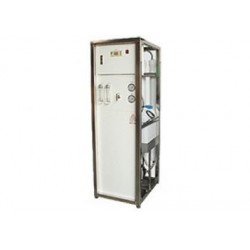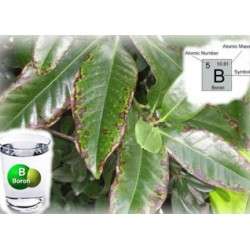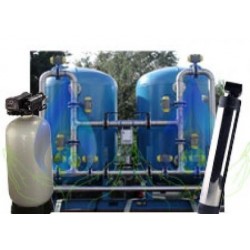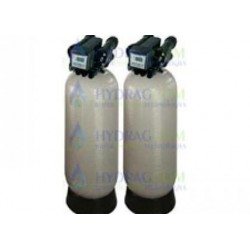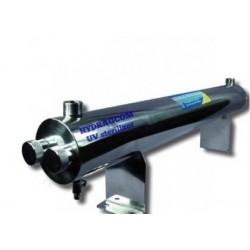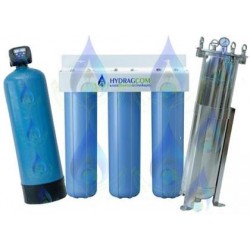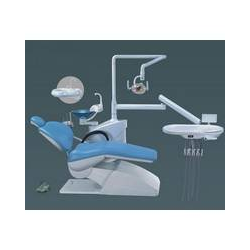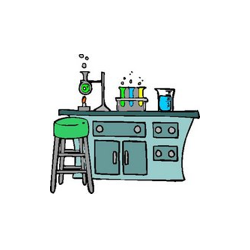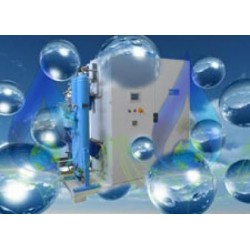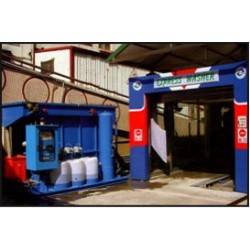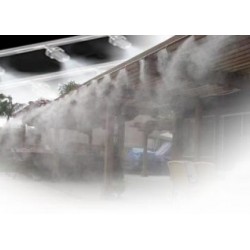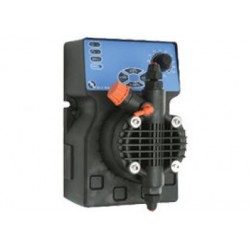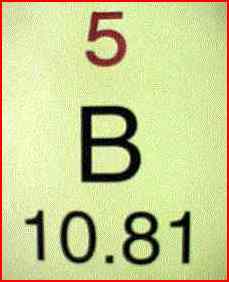 Boron is a chemical element with symbol B and atomic number 5. Boron is an essential plant nutrient required primarily for maintaining the integrity of cell walls. However, high soil concentrations of greater than 1.0 ppm lead to marginal and tip necrosis in leaves as well as poor overall growth performance. Levels as low as 0.8 ppm produce these same symptoms in plants that are particularly sensitive to Boron in the soil. Nearly all plants, even those somewhat tolerant of soil boron, will
Boron is a chemical element with symbol B and atomic number 5. Boron is an essential plant nutrient required primarily for maintaining the integrity of cell walls. However, high soil concentrations of greater than 1.0 ppm lead to marginal and tip necrosis in leaves as well as poor overall growth performance. Levels as low as 0.8 ppm produce these same symptoms in plants that are particularly sensitive to Boron in the soil. Nearly all plants, even those somewhat tolerant of soil boron, will
show at least some symptoms of Boron toxicity when soil Boron content is greater than 1.8 ppm. When this content exceeds 2.0 ppm, few plants will perform well and some may not survive. Boron has been found to be potentially harmful in drinking water. Boron in drinking water behaves like silica.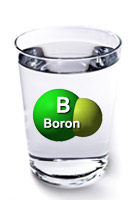
Most of the world's Boron is contained in sea water. Sodium borate in water occurs in arid regions where inland seas once existed but the water has long since evaporated. Boron in water is frequently present in fresh water supplies in these same areas in the form of non-ionized boric acid. Elemental boron in water and borates are non-toxic to humans and animals and is very similar to common table salt. Generally speaking Borates are more toxic to insects than to mammals.
Boron and its related compounds and by-products may be found in groundwater because of pesticide and fertilizer runoff, sewage spills, and coal production. Borax isa form of boron and is found in many household items including cleaning and laundry solutions.
The process for removing Boron can depend on the type of application. In Hydragcom, we have filtering solutions for Boron Removal, like anion exchange filters , reverse osmosis, etc.
No products
Subcategories
Industrial Reverse...
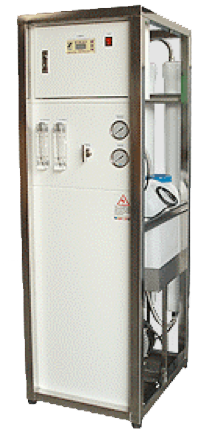
Reverse Osmosis is a technology that is found virtutally anywhere Pure Water is needed. The Commercial & Industrial common uses of Reverse Osmosis Systems include:- Drinking Water
- Humidification
- Ice-Making
- Car Wash Water Reclamation
- Rinse Waters
- Biomedical Applications
- Laboratory Applications
- Photography
- Pharmaceutical Production
- Kidney Dialysis
- Water used in chemcial processes
- Cosmetics
- Animal Feed
- Hatcheries
- Restaurants
- Greenhouses
- Metal Plating Applications
- Wastewater Treatment
- Boiler Water
- Battery Water
- Semiconductor production
- Hemodialysis and many more
Hydragcom distributes a large range of high quality reverse osmosis systems and components. Our wide range of technologies and the extended "know-how" in all water related sectors will guarantee you a cost-effective solution meeting your water quality requirements. Our products and services are custom designed to meet any individual needs !Boron Removal Filters
Iron and Manganese...

Iron and Manganese (and Hydrogen Sulfide) occur naturally in groundwater. Water containing excessive amounts of iron and manganese can stain clothes, discolor plumbing fixtures, and sometimes add a “rusty” taste and look to the water. Surface water generally does not contain large amounts of iron or manganese, but iron and manganese are found frequently in water systems that use groundwater. The Safe Drinking Water Act secondary standards (aesthetic, not health related) for iron in drinking water is 0.3 parts per million (ppm) and 0.05 ppm for manganese.
Iron contamination can be found in two general forms, ferric iron which consists of particles of solid iron (rust) and ferrous or dissolved iron. In addition to causing an unpleasant metallic taste, iron in drinking and household water can cause unsightly staining of plumbing fixtures and laundry.Manganese can give water an unpleasant taste and it can cause discolouration
especially when sterilising fluids such as chlorine are added to the water. At these levels, manganese will also cause discolouration of clothes and utensils. The visible effect of manganese is apparent by the appearance of small black particles in your water which may give the water a dirty appearance. In large quantities, these particles can also cause problems by blocking valves and pipes and accumulating in tanks.
Iron and manganese in water also promote the growth of bacteria (including iron bacteria). These organisms obtain energy for growth from the chemical reaction that occurs when iron and manganese mix with dissolved oxygen. These bacteria form thick slime growths on the walls of the piping system and on well screens. These shines tend to be are rust-colored from iron and black-colored from manganese. Variations in flow can cause these slim e growths to separate from pipe walls, resulting in dirty water in the system.
In Hydragcom several treatment methods (oxidation, clarification, mechanical filtration, ion exchange, etc) are used. Our Iron Water Filter systems effectively remove Iron, Manganese, and Hydrogen Sulfide (rotten egg smell) from municipal or well water supplies.Industrial Water...
Hard water contains calcium and magnesium ions. A water softener is a water treatment device used to treat hard water. Water softeners use resin beads, which hold sodium ions. When hard water passes through the resin beads inside the softener, the beads attract and hold calcium and magnesium ions and give off sodium ions. After this process, the water leaving the softener is soft.
Salt water is used to wash the resin beads. The brine solution loosens the hardness ions, which have built up on the resin beads; then the system backwashes and flushes the hardness minerals away. Once again the system is ready to soften more water. The resulting soft water requires less soap for the same cleaning effort, as soap is not wasted mopping up calcium ions. Soft water also extends the lifetime of plumbing by reducing or eliminating scale build-up in pipes and fittings.
Softeners can be used in a variety of services including: industrial, municipal, and institutional applications, including apartments/condominiums, preparation of drinking water, water in breweries & sodas, cooling towers, hospitals, hotels, ground water remediation, boiler feed-water, car washes, reverse osmosis pre-treatment, laundries and many others.
In Hydragcom, We offer and Specialize in both water softeners and no salt water conditioners. It is a NEW model of Water Softener - ECOLOGICAL WATER SOFTENER. Approved for aquariums, for food use or human use, for animals, plants, heating systems and heat convectors, irons. It can be very easily installed and no electrical supply is needed, nor any addition of salt, discharge tubes or tap and no "overflow" system either (for drainage into the floor).
Hydragcom’s water softening systems ( single, duplex, triplex or multi-unit) are designed to remove hardness in both high and low water demand conditions. Designed with top performance and ease of maintenance in mind and can be used for commercial and industrial applications where a high-performance calcium / hardness reduction system is desired.
Industrial...
Ultraviolet (UV) disinfection uses a UV light source, which is enclosed in a transparent protective sleeve. It is mounted so that water can pass through a flow chamber and UV rays are admitted and absorbed into the stream. When ultraviolet energy, with a 235.7nm wavelength, is absorbed by the reproductive mechanisms of bacteria and viruses, the genetic material (DNA/RNA) is rearranged and they can no longer reproduce, are dead and the risk of disease has been eliminated. The treated water then exits through the top port of the cell and is ready for consumption.
The UVI systems virtually eliminate microbiological contaminants without using potentially hazardous chemicals, without adding or taking anything away from water. The UV disinfection is a cost-effective and environmentally-friendly way to remove 99.99% of harmful waterborne microorganisms.
UV-rays are energy-rich electromagnetic rays that are found in the natural spectrum of the sunlight. They are in the range of the invisible short wave light having a wavelength ranging from 100 to 400 nm (1 nanometre = 10-9m).
Research has confirmed that UV effectiveness is relatively insensitive to temperature and pH differences, and that application of UV as a primary disinfectant (followed by chlorination or chloramination) does not contribute to disinfection by-product formation. In addition, UV application was found not to convert nitrate to nitrite or bromide to bromines or bromates. However, it has long been observed that turbidity, natural organics, iron, calcium hardness, suspended solids, and other factors can reduce UV transmission and cause lamp fouling, thus lowering disinfection effectiveness. Ultraviolet devices are most effective when the water has already been partially treated, and only the cleanest water passes through the UV flow chamber.The Ultraviolet method of microbiological eradication is commonly used for hospitals, homes, hotels, cottages, schools, waste water treatment, green houses, farms, beauty shops, aquaculture, aquariums, food & beverage industries, laboratories, etc.
Laboratories and factories with low water use but high quality requirements can take advantage of UV disinfection systems to treat their water. Some processes are unable to tolerate chlorine, and the food and beverage industry wants to eliminate the odour and taste of chlorine from their products.
Ultraviolet sterilizers are often used in aquaria and ponds to help control unwanted microorganisms in the water. Continuous sterilization of the water neutralizes single-cell algae and thereby increases water clarity. The UV radiation also ensures that exposed pathogens cannot reproduce, thus decreasing the likelihood of a disease outbreak in an aquarium.
Disinfecting the water with U.V (ultraviolet) light is natural, environmentally safe, cost effective, it's well proven and it's the way of the future for water disinfection requirements around the globe.
Industrial...
 The Industrial Prefilters are tasked to process large amounts of water. Commercial and Industrial pre-filtration is the process by which particles (or suspended solids, Iron, Silica, Organic material) and turbidity are removed from water or wastewater. The removal of sediment and other suspended particles is critical to the clean operation of any system in order to produce water that's acceptable for industries. Many different types of commercial filters can be used to remove suspended solids. Sometimes only a single type of industrial filter is required to achieve the desired water quality. In other cases, several different types of filters in a specific sequence may be required.
The Industrial Prefilters are tasked to process large amounts of water. Commercial and Industrial pre-filtration is the process by which particles (or suspended solids, Iron, Silica, Organic material) and turbidity are removed from water or wastewater. The removal of sediment and other suspended particles is critical to the clean operation of any system in order to produce water that's acceptable for industries. Many different types of commercial filters can be used to remove suspended solids. Sometimes only a single type of industrial filter is required to achieve the desired water quality. In other cases, several different types of filters in a specific sequence may be required.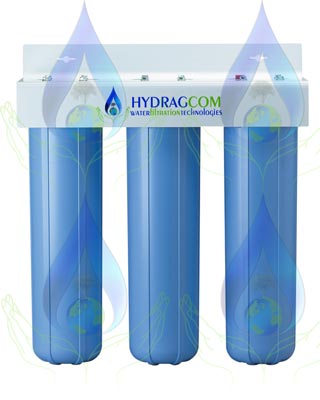
Hydragcom has a number of pre-treatment solutions that are used to increase the lifespan, improve the performance of process equipment downstream and help the water to be recycled or meet environmental disposal guidelines. These include Self-Cleaning Filters, Bag and cartridge filters, Sand filters, Dual-media filters, Multi-media filters, etc.
Hydragcom provides a wide range of industrial water filters and industrial water filtration systems for engineering-heavy industries. These filters can be used in the pre- treatment of: irrigation systems, snowing systems, heat exchangers, cooling circuits, boilers, machine tools, car washing, laundry, waste water, pre-treatment for reverse osmosis systems, food industries and many others.
Hydragcom has one of the widest range of filtration technologies available on the market to meet the specific needs of any relevant industry.Hairdressers and...
Hairdressers & Beauty Salon Water Filters
Beauty Salons & Hairdressers want to offer the very best for their customers! The tap water is full of chlorine. While this is good at killing bugs, it does not do any favours to your customer’s hair - or your staff's skin and respiratory. Chlorine water leaves hair bleached and / or feeling coarse. Regular exposure can cause brittle hair and dandruff. The chlorine also strips out colourants and affects tints.
The tap water is full of chlorine. While this is good at killing bugs, it does not do any favours to your customer’s hair - or your staff's skin and respiratory. Chlorine water leaves hair bleached and / or feeling coarse. Regular exposure can cause brittle hair and dandruff. The chlorine also strips out colourants and affects tints.
Medical studies suggest that chlorine aggravates existing eczema or asthma. Perhaps this isn't surprising when you consider that the original use of chlorine was as a nerve gas for use in warfare. Since 50% of our daily chlorine exposure comes from showering, it is important to shower in clean, chlorine free, filtered water!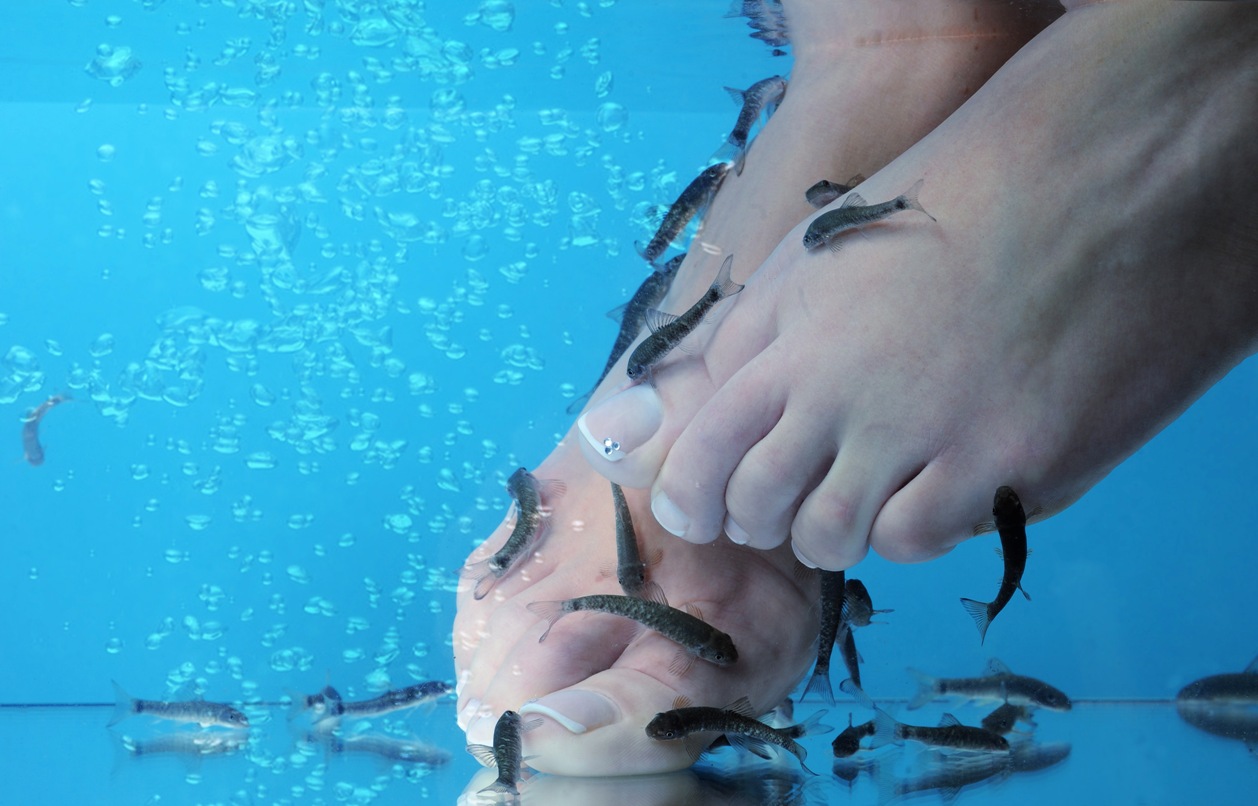
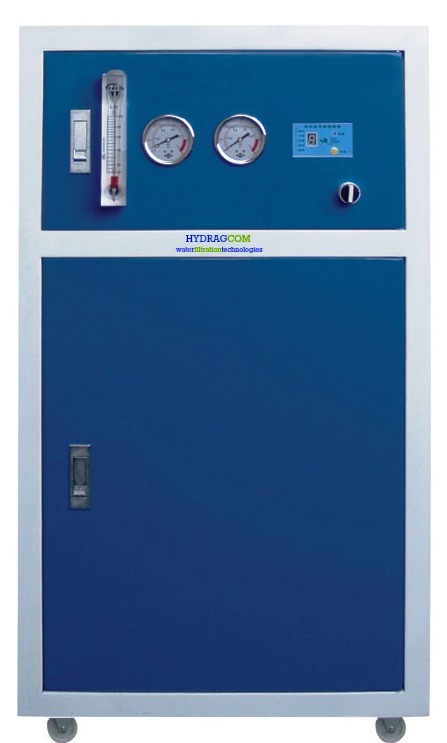 Another enemy for your hair and skin is the hard water. It should be noted that laboratory experiments have concluded that there was little appreciable difference in the tensile strength and elasticity of hairs after they were treated with hard and soft
Another enemy for your hair and skin is the hard water. It should be noted that laboratory experiments have concluded that there was little appreciable difference in the tensile strength and elasticity of hairs after they were treated with hard and soft
water. Anecdotally, however, water with a high mineral content might make your hair feel drier and more brittle, which can contribute to hair loss. If this is your experience there are some steps you can take. Softening the water you use to wash your hair & body can help you have a healthy and strong head of hair and soft (baby) skin!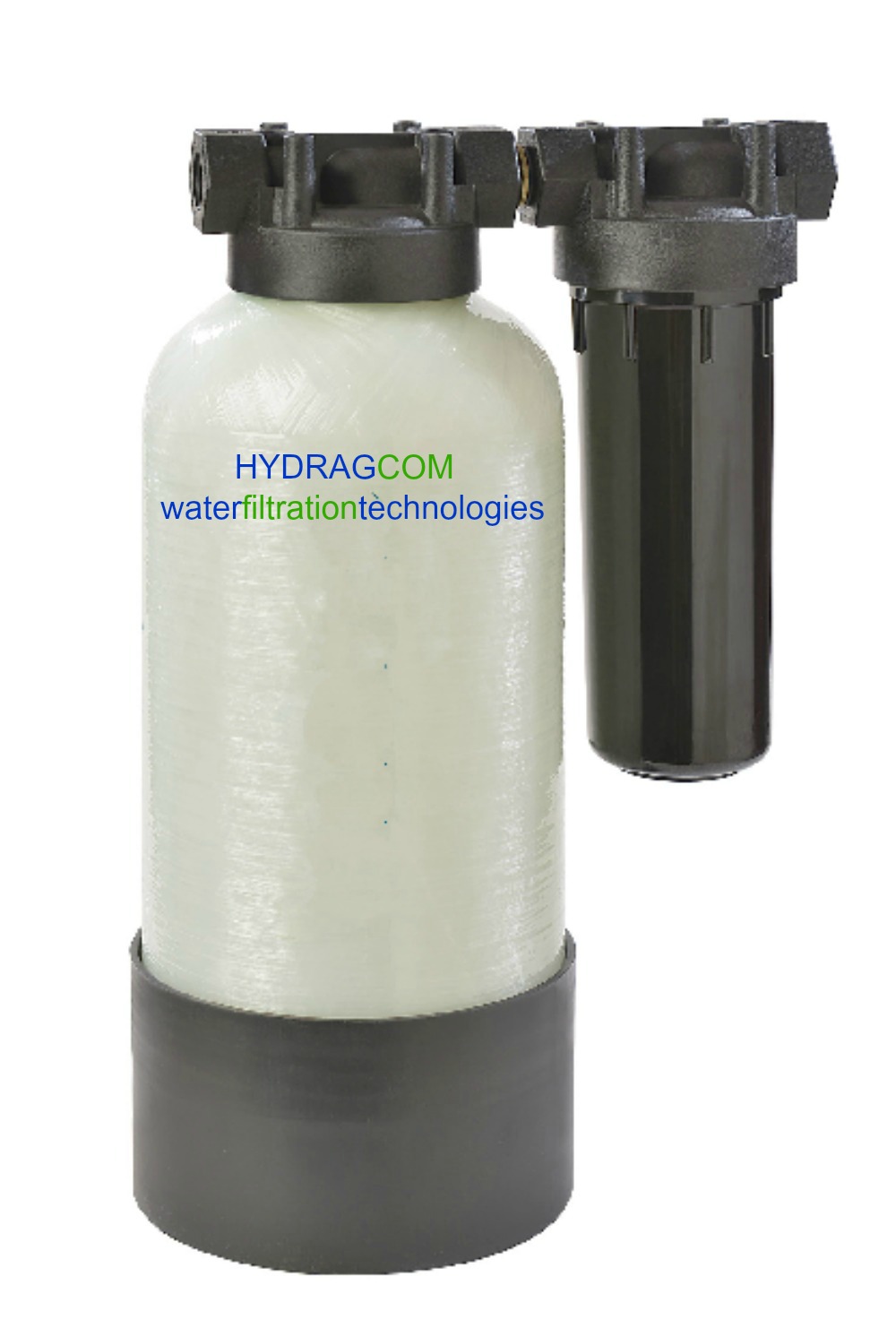
In Hydragcom we can provide solutions with a wide range of water filtration systems for the effective removal of chlorine, heavy metals and hardness in hair salons, beauty salons, spa, hydromassages, etc at the lowest possible cost, considering the functionality, accessibility and aesthetics of the place.
Dental Surgeries
Scientists exploring infection control problems have been discovering an alarming amount of evidence regarding the safety of the water that is sprayed into the mouth from dental instruments.
A recent study documented in the Journal of the American Dental Association concluded that "Microbial contamination of dental unit water appears widespread and the organisms populating the water lines include many with pathogenic potential which can cause serious illness and death, especially when the immune systems are down".
Among the recent findings: standard microbial culture techniques, as well as new analytical techniques, have revealed extraordinary numbers of a wide variety of waterborne "opportunistic" pathogens. These bacteria are quick to take advantage when the immune system defenses are low, with immuno-compromised patients especially at risk. The bacteria found in dental water lines may cause significant infection in these individuals.
Cystic fibrosis, which occurs in one in 3500 Caucasian births, results in chronic pulmonary disease. Death is most often the result of respiratory failure, typically after many episodes of lung infection. The most common cause of these infections is pseudomonas, which are the dominant bacteria found in dental spray water. Legionella, the bacteria which cause Legionnaires' disease, are present in dangerously high concentrations in the majority of dental chairs. A prominent California dentist recently died of Legionella; the strain of bacteria found in his lungs was present in high concentrations in his office dental water lines.
The Center For Disease Control has implicated Legionella bacteria as a major complication for people with AIDS. In addition to the well-publicized immune system problems encountered by HIV and AIDS patients, other at-risk elements of the population include individuals with cystic fibrosis, , diabetes, asthma, sickle-cell anemia, those receiving chemotherapy, recreational drug users, transplant patients, heavy antibiotic users and the elderly.The source of these maverick bacteria which inhabit the dental unit water lines is two fold. First, research indicates that the majority of the organisms originate in the municipal water system. Conventional municipal water treatment procedures are proving inadequate in dealing with a wide variety of these "super bugs".
The tiny dental water lines provide a large interior surface area combined with low flow rates and stagnation, two ideal conditions for the formation of a thin slime of microbes called "biofilm" on the interior surfaces of the dental lines.
We supply the dental surgeries with special , high quality, reliable units that remove up the impurities from mains water and provide deionized and microbiologically safe water! For dental surgeries (HDRO series), provided perfectly clean water, free of salts to prevent crust creation inside the machine and onto the sterile instruments, while the water is microbiologically tested simultaneously safeguarding the health of dental patients.
Χημικά &...
Ozonation
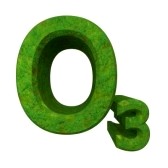
In 1785, the Dutch chemist Martinus Van Marum was conducting experiments involving electrical sparking above water when he noticed an unusual smell, which he attributed to the electrical reactions, failing to realize that he had in fact created ozone.
Ozone (or trioxygen) is an inorganic molecule with the chemical formula O3. Ozone is a colorless gas that has an odor similar to the smell of the air after a major thunderstorm. Ozone is an unstable molecule which readily gives up one atom of oxygen providing a powerful oxidizing agent which is toxic to most waterborne organisms.
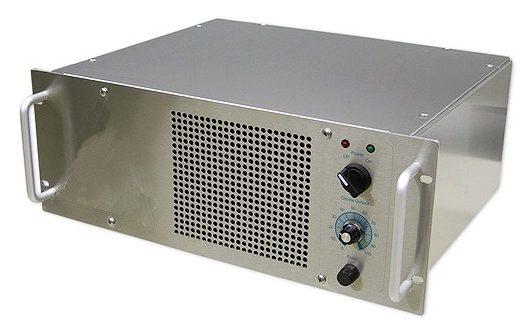 The Ozone can be artificially produced, by generators, so that it can be used for water treatment disinfection. The ozone generators can create ozone artificially by means of extremely high voltages or by means of UV-light. Both methods involve the decomposition of the oxygen molecule. This causes oxygen radical formation. These oxygen radicals can bind to oxygen molecules, forming ozone (O3).
The Ozone can be artificially produced, by generators, so that it can be used for water treatment disinfection. The ozone generators can create ozone artificially by means of extremely high voltages or by means of UV-light. Both methods involve the decomposition of the oxygen molecule. This causes oxygen radical formation. These oxygen radicals can bind to oxygen molecules, forming ozone (O3).
It is an effective method to inactivate harmful protozoa that form cysts. It also works well against almost all other pathogens. Ozone is made by passing oxygen through ultraviolet light or a "cold" electrical discharge. To use ozone as a disinfectant, it must be created on-site and added to the water by bubble contact. Some of the advantages of ozone include the production of fewer dangerous by-products and the absence of taste and odor problems (in comparison to Chlorination). Another advantage of ozone is that it leaves no residual disinfectant in the water. In addition, the oxidizing properties can also reduce the concentration of iron, manganese, sulfur and reduce or eliminate taste and odor problems. Ozone oxides the iron, manganese, and sulfur in the water to form insoluble metal oxides or elemental sulfur. These insoluble particles are then removed by post-filtration. However, although fewer by-products are formed by ozonation, it has been discovered that ozone reacts with bromide ions in water to produce concentrations of the suspected carcinogen bromated.Hydragcom supplies ozone generators (Ozonators) for ozone disinfection applications including drinking water, cooling water, spas, swimming pools, aquaculture, pharmaceutical industries, waste water treatment and many others.
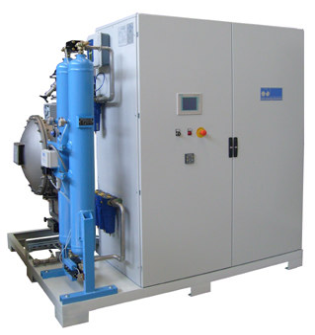
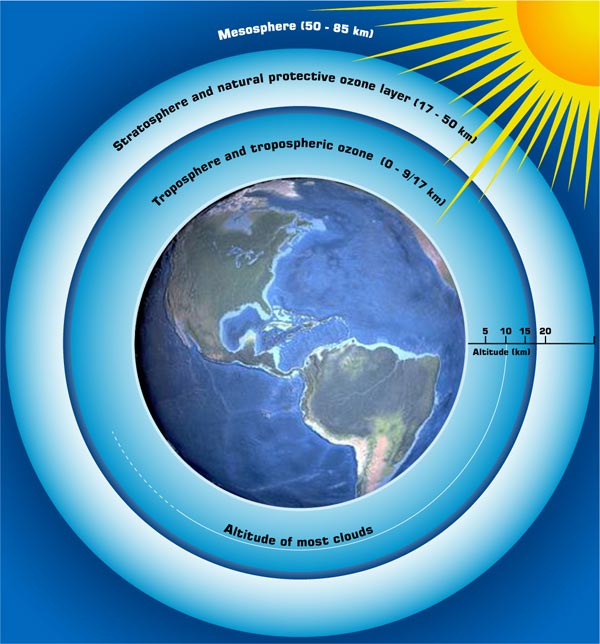
Car Wash Systems

The environmental protection is the most important topic for enterprises nowadays, specially the precious of water resources needs to treasure well. Hydragcom’sCar Wash Water Recycle System was developed because the enterprises need of the most economical way to recycle and re-use the waste water. Generally speaking, the car washer discharges the sewage which contains froth, wax, oil, silt and so on. The matters that don't dissolve in water (like silt), which can be removed by filtration. But for the matters that dissolves in water (like forth, wax) can't be filter away. The use of activated carbon adsorption has only small effect and also the cost excessively is high, non-economic efficiency.
Hydragcom’s Car Wash Water Recycle System has included with dosing systems appropriate for the waste water treatment, which can removes the matters of forth, wax, etc. from the sewage, and make them float on the surface of the skimmer to be collected to the dross tub, archived the goal of water purification.
Hydragcom’s Car Wash Water Recycle System has powerful function for waste water treatment. It is not only waste water recycling treatment for car washer, but it also has very good result in waste (sewage) water treatment for other applications. This system has been modulized, and built within water and electrical indicators and chemical dosing systems, True ALL-IN-ONE System. Easy for site installation, only need to plug the power source and In & Out water pipe.No matter your requirement- Hydragcom will assist in any capacity that you require!
Mist Cooling Systems

Misting systems work by forcing water via a high pressure pump and tubing through a brass and stainless steel mist nozzle that has an orifice of about 5 microns thereby producing a micro-fine mist. The water droplets that create the mist are so small that they instantly flash evaporate. Flash Evaporation can reduce the surrounding air temperature by as much as 35 °F (20 °C) in just seconds.
Water mist systems are economical and versatile. Are used for cooling, humidification, odor neutralization, dust abatement, and air filtration. Water mist systems are great for patios and outdoor seating areas in restaurants, resorts, or sports facilities. Greenhouses benefit greatly as well, and many consider misting units to be standard equipment that increases plant health and productivity. Also, industrial dust suppression may be accomplished effectively and economically in areas such as mines, grain silos, cement plants, rock quarries, etc.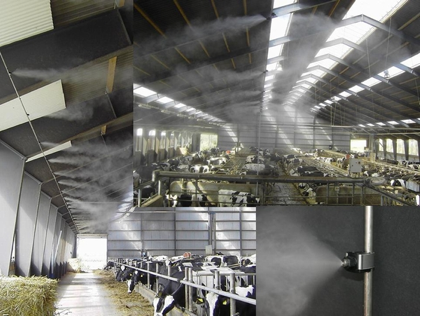
Water mist systems begin with a high pressure pump and a spray nozzle designed to produce tiny water droplets that cool the air as they flash evaporate. Performance is enhanced by increasing the number of nozzles used and adjusting the water pressure. In drier climates, temperatures may be reduced by 30 degrees Fahrenheit without a noticeable increase in relative humidity.
Hard water is the water that has high-mineral content unlike soft water. It is formed when water seeps through limestone and chalk deposits which are made of magnesium carbonates and calcium. Hard water deposits not only clog nozzles and mister pumps that lower mist quality, causing a disrupted flow of water through the misting pump and out of the misting nozzles but they also result in costly breakdown of the equipment that handles this water flow.

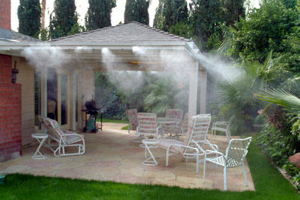
Water filtration is critical to protect the misting pump and to prevent clogged nozzles in all high pressure misting systems. To ensure clean, safe and hygienically clean water for cooling and humidification systems, Hydragcom offers a complete range of water treatment and filtration systems, including sediment & phosphate cartridges, DI, RO and UV systems to eliminate inorganic contaminants, reduce dirt, and prevent scale and rust deposits from damaging tubing and brass nozzles.
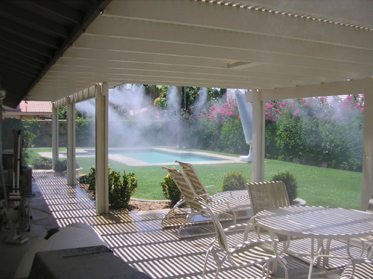
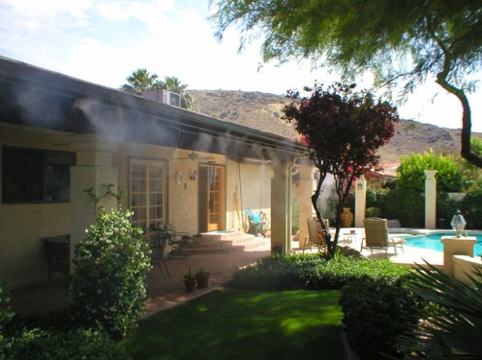

Chlorination Dosing Pumps
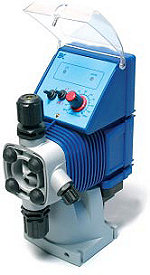
Water Chlorination is one of many methods that can be used to disinfect water. It is the process of adding various types of chlorine (Cl 2) or hypochlorite to waterfor the oxidation and disinfection of what will be the potable water source. Any type of chlorine that is added to water during the treatment process will result in the formation of hypochlorous acid (HOCl) and hypochlorite ions (OCl-), which are the main disinfecting compounds in chlorinated water.
Chlorine inactivates a microorganism by damaging its cell membrane. Once the cell membrane is weakened, the chlorine can enter the cell and disrupt cell respiration and DNA activity (two processes that are necessary for cell survival). The amount of chlorine that is required to disinfect water depends on the impurities in the water that needs to be treated. Many impurities in the water require a large amount of chlorine to react with all the impurities present.
Chlorination is the process of adding chlorine to water as a method of water purification (disinfection) to make it fit for human consumption. The water that has been treated with chlorine is effective in preventing the spread of disease.
Chlorination is mainly used on systems where the point of use is away from the source or storage tanks are being used. A chlorine-dosing pump will add a carefully measured amount of diluted chlorine to the system as the water passes into a tank. A wide variety of chemicals can be pumped (either gas chlorine, electrochemically generated chlorine, sodium hypochlorite or calcium hypochlorite). The amount of chlorine in the water needs to be monitored continuously to ensure the level stays within the recommended limits, too little and not all the contaminants will be destroyed, too much is bad for human health.
Chlorination method was first used over a century ago in Great Britain and then expanded to the United States in 1908 and Canada by 1917. Today, chlorination is the most popular method of disinfection and is used for water treatment all over the world.
The chlorination process is inexpensive, fairly easy to implement, when compared to other water treatment disinfection methods. It is effective against almost all bacteria and viruses as well as algae, fungi, some minerals and man-made chemicals pollutants. As with mains water a small amount of disinfectant is usually intentionally left in the water at the end of the treatment process ("residual chlorine") to reduce the risk of re-contamination in the distribution system. In addition, chlorine will also oxidize any iron, manganese and/or hydrogen sulphide that are present, so that they too can be removed in the sedimentation and filtration steps.
Hydragcom can supply and install chlorine dosing systems. Our chemical dosing pumps, in a unique design that allows for both foot- and wall-mounting, deliver accurate metering of chemicals, proven reliability, cost effective and easy installation.
Hotels- café- restaurants
The best drink . . . is made with quality water
The quality of the water represents 95% of the success of a drink.
It is often forgotten that a cup of coffee is 98% water. The invisible chemicals and minerals that are dissolved in the feed water can have a dramatic and occasionally disastrous effect on the taste of the coffee! A commercial water filtration system used in your coffee brewer blocks contaminants to ensure that your beverages are sanitary, safe and great tasting! Filters prevent minerals and other sediment from clogging the internal components or your machines to increase its efficiency, lower your energy costs, extend the life of your coffee equipment and guarantee flavor and tastes to all the drinks.
The pure water is the most crucial component in any steam cooker. The majority of maintenance issues and breakdowns for steam equipment are due to sediment buildup and calcification in the boiler component of the unit. A proper commercial water filtration system for your food steamer can prevent unwanted buildup of sediment, cysts, lime, calcium, chlorine bad taste & odor to keep your machine running in peak condition.
The Ho.Re.Ca. (Hotel, Restaurant, Café) is constantly affected by water requirements and important drinking water. We can supply and maintain a large range of commercial filtration systems (such as filtration, adsorption, ultrafiltration, uv, ion exchange mineralization, reverse osmosis, etc ) for all types of food service equipment requirements. From the systems for the production of adequate quantities of water that meets the specific needs of users to equipment capable of providing high quality, safe, drinking water and ice!

